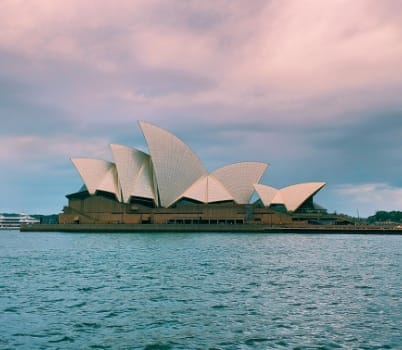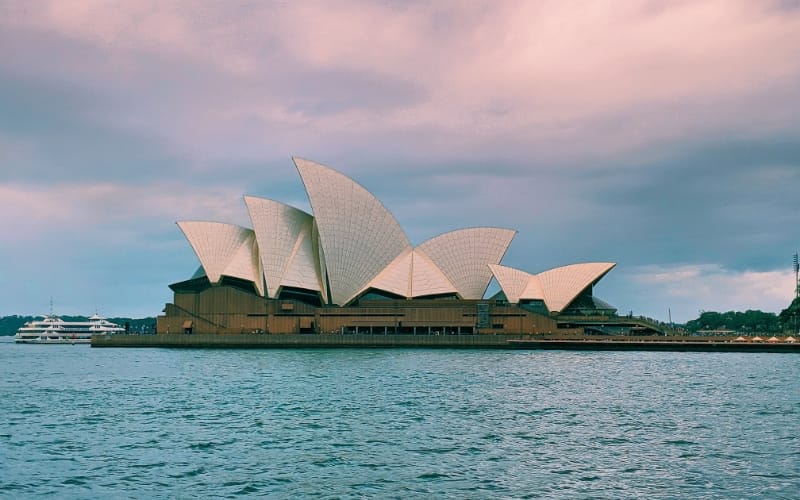
God’s heaven on Earth, everything is fine, people are living their lives, tourists are in too, animals are saved in their homes.
Then, on 20 November 2019 A large fire broke out on Yorke Peninsula and threatened the towns of Yorktown and Edith burgh.
Yes, we know Australia has always had bushfires, but 2019 is like nothing we’ve seen before!
Scientists say the lack of moisture in the landscape is a key reason this year’s bushfire have been so severe and the climate crisis is behind the lengthening of the fire season.
In addition, record low rainfall has contributed to a continent scale emergency that has burned through more than 5m hectares and alarmed scientists, doctors and firefighters
As the area burned across Australia this fire season pushes beyond five million hectares, an area larger than many countries, stories of destruction have become horribly familiar.
People have been killed. Balmoral, in the New South Wales southern highlands, is the latest community affected in a state where up to 1,000 homes have been destroyed. A third of the vineyard area and dozens of homes were razed in the Adelaide Hills. It is too early for a thorough examination of the impact on wildlife, including many threatened species in the fires’ path.
The NSW Rural Fire Service says the scale of what has burned in that state is unprecedented at this point of the fire season. The firefighting agency in the state worst affected.
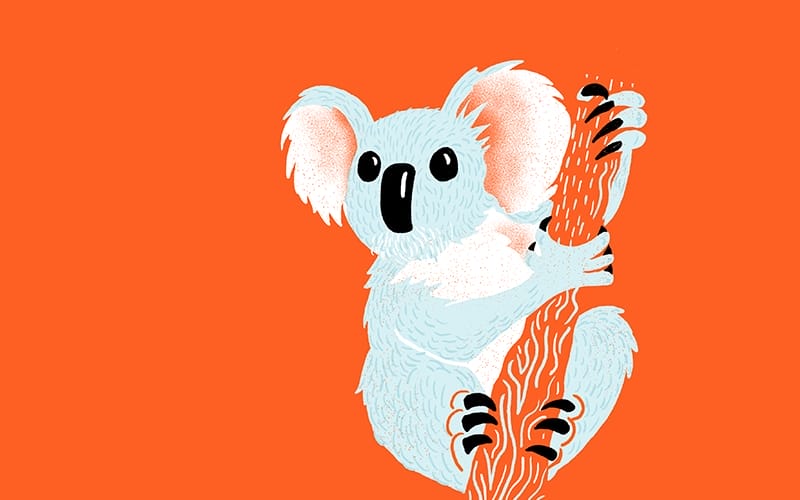
By: https://dribbble.com/shots/9412258-Australia
A slightly larger area burned across the 1974 calendar year, the difference is, those fires were of an entirely different nature: above average rainfall before the fire season meant fuel in the outback was unusually plentiful, and fire burned through well-grown grasslands in the state’s far west.
But, this year’s fires are further east, where people live, and have been fuelled by a vast bank of dry fuel following the country’s record-breaking drought. Soil moisture is at historic lows in some areas, and rainfall in the first eight months of the year was one of the lowest on record in the northern tablelands and Queensland’s southern downs.
What does the science say?

By: https://dribbble.com/shots/9807940-Koala-s-family
David Bowman, director of The Fire Centre at the University of Tasmania, says the most unbelievable thing about this fire season is the continent-scale nature of the threat.
Bowman says: “The geographic range, and the fact it is occurring all at once, is what makes it unprecedented, there has never been a situation where there has been a fire from southern Queensland, right through NSW, into Gippsland, in the Adelaide Hills, near Perth and on the east coast of Tasmania. And one of the less explored issues, though it has begun to receive some attention in recent days, is the economic impact of having prolonged fires that affect so many Australians.”
He says: “I’m not quite certain why anybody would want to be claiming fires have been like this before. It’s concerning as it is a barrier to adaptation. To deal with these sorts of fires the first step is to acknowledge the scale of the problem.”
Ross Bradstock, from the University of Wollongong’s Centre for Environmental Risk Management of Bushfires, points to the Gospers Mountain fire, which started in a lightning strike north-west of Sydney in late October, as evidence of how this season differs from what has come before.
But he says it was almost certainly the largest single ignition-point forest fire recorded in Australia and, for mid-latitude forests, possibly the world. He says it is bigger than any in California and Mediterranean Europe.
“We can find no evidence of forest fires of that size anywhere, you just don’t see fires of this size in these parts of the world because you do not usually get the extreme dryness and unrelenting nature of the weather.”
Two months in, Bradstock says the Gospers Mountain is a monster, “just unimaginably big” and near impossible to contain unless there is substantial rain.
What about the smoke? What about the pollution?
The smoke that has choked Sydney, Canberra and other centres and towns in recent weeks has produced pollution up to 11 times greater than the engraved the level for human health. In Sydney, the air pollution has been hazardous for at least 30 days.
NSW’s director of environmental health, Richard Broome, said: “an unprecedented emergency from a smoke point of view, We haven’t seen conditions like this in Sydney, certainly in anyone’s memory that I’ve spoken to”
Dr. Kate Charlesworth, a fellow of the Royal Australasian College of Physicians, said: “There is early evidence that the number of people turning up at hospital emergency departments needing help is higher than usual. there was no safe level of air pollution, and that the most vulnerable in the community babies, children, the elderly and people with pre-existing disease were the most likely to be affected.”
Climate change, what is the role it plays?
As we know, greenhouse gas emissions do not cause bushfires, but they play a demonstrated role in increasing average and extreme temperatures and contribute to the extraordinarily dry conditions affecting eastern Australia.
Scientists cite the near absolute lack of moisture in the landscape as a key reason the fires have been so severe.
Studies have found the climate crisis is lengthening the fire season.
As Australia’s fire season is more overlapping with that in California, making resource-sharing more difficult, it is also running simultaneously across the country.
What about the Animals?
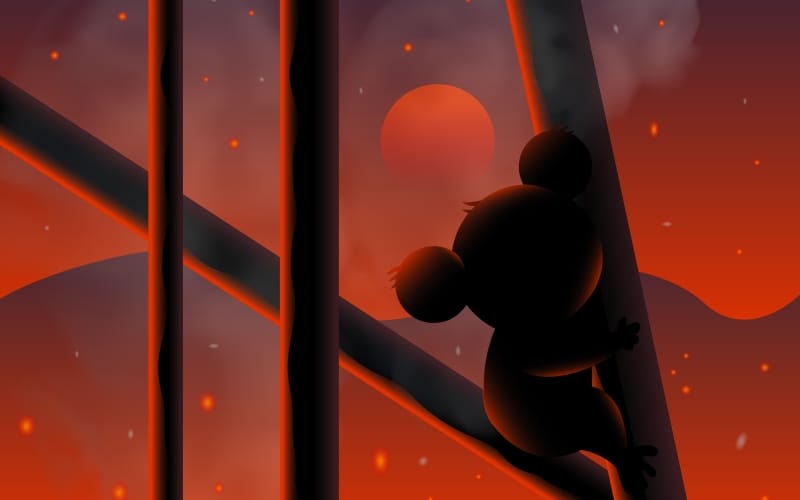
By: https://dribbble.com/shots/9529305-Pray-for-Australia
Australia is in the midst of an animal extinction crisis and the loss of almost 20 unique species in coming years is inevitable, already three native species had been wiped out in the past decade.
That’s the dire warning following the release of a damning interim report about the inadequacies of current environmental laws.
A Senate inquiry report released found the current approach to wildlife protection was incapable of stopping the spiralling rates of extinction and recommended a complete overhaul of legislation.
Suzanne Milnthorpe, national nature campaign manager at the Wilderness Society, said: “The evidence is clear Australia is in an extinction crisis, We’re number two in the world for species loss, and if we keep turning a blind eye to major threats to wildlife like deforestation, even iconic animals like the koala will go.”
Well, that’s all was before the bushfire’s crisis of 2019,
Millions of hectares have been lost, with a tragic impact on wildlife and flora.
Among the destruction, the efforts of volunteer firefighters, residents and animal rescuers have stood out, with acts of heroism that have saved many animal lives. A few have become emblematic images of this year’s terrible fire season.
However, the Animals victim numbers are still rising, and the danger of species extinction is certain!
Who is fighting?
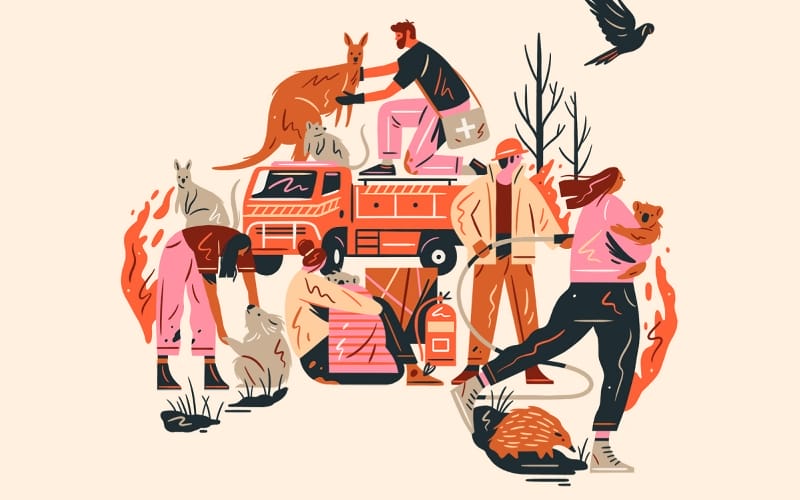
By: https://dribbble.com/shots/9661999-Australian-Forest-Fire-Fundraiser
The majority of these fires are burning in regional and rural areas where volunteer firefighting services are the chief firefighting organizations. The New South Wales Rural Fire Service has around 70,000 members, but most of them are performing unpaid work to protect the lives and homes.
American and Canadian firefighters and fire experts have been flown in over the past month to help control the blazes. Over 100 US firefighters have been flown in, with more flying out on Jan. 6.
A report by the BBC suggests approximately 3,000 firefighters are on the ground every day battling blazes.
The Australian government announced that would be sending in military support including the country’s largest warship, HMAS Adelaide, to help evacuate regional communities on Victoria’s coast. Additionally, 3,000 army reservists were asked to assist in fire recovery efforts. Four extra water-bombers have been leased to provide additional air support.
Let’s not forget about the efforts of volunteering heroic work of the residents and animal rescuers that have stood out, with acts of courage that have saved many humans and animals lives. Some of them have become symbolic images of this year’s terrible crisis.
How can we help?
A number of organizations and volunteer services are aiding in the firefighting and recovery efforts for affected communities. Whether you want to help the firefighting organizations, wildlife or just provide somewhere to sleep. Or if you can’t do any of this You can just:
Increase Awareness! You can tweet and share and post this story, and dozens of others all across the web.
More eyeballs = more help.
Tell us how you raised awareness to help Australia?
